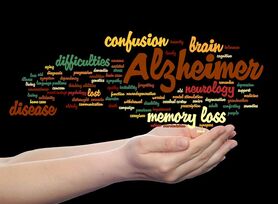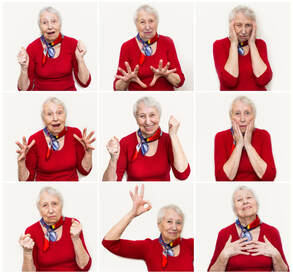Research in the Cognition & Aging lab is broadly focused on understanding how social context and socioemotional goals affect memory in younger and older adults. We pursue this objective in three lines of research, which are each described in more detail below.
(1) Stereotype threat and older adults' memory performance
|
Stereotype threat occurs when people are concerned that poor performance will confirm a negative self-relevant stereotype. In response to this, people can underperform compared to their potential. For example, when older adults are placed in situations where they could confirm the stereotype that ‘older adults are senile and not cognitively capable’ they can experience stereotype threat and underperform on memory tests. Research in our lab has shown that these effects are driven (at least in part) by changes in task motivation. When older adults encounter stereotype threat it induces a risk-averse, prevention motivational focus. Rather than eagerly approach the gains that will make them their best, stereotype threat leads older adults to vigilantly avoid the losses that will make them their worst. This has important clinical implications. Research in our lab has shown that stereotype threat can impair older adults' performance on the brief cognitive tests that are used in primary care settings to screen for dementia. With the support of funding from the National Institute on Aging, our research has also focused on (a) examining the mechanisms underlying this effect, (b) identifying which older adults are most affected by stereotype threat, and (c) testing the efficacy of interventions to eliminate stereotype threat and therefore improve older adults' performance.
|
(2) Collaborative memory and illusory truth effects
|
Remembering the past is often a social activity. People collaboratively remember the events of their lives with close others, juries collectively recall trial events before reaching verdicts, students participate in study groups to master lecture materials, and patients in therapy groups share their experiences as part of treatment. Research in our lab has focused on how collaboration affects the quantity and quality of what people learn and remember. More recently, we have also examined the intersection of memory and belief.
During interactions with others, it is also common for certain claims to be repeated, and research has shown that repeated information is often perceived as more truthful than new information. This finding is known as the illusory truth effect, and it helps explain why advertisements and propaganda work, and why people believe fake news to be true. Recent research in our lab has examined when and why repetition impacts belief, and how this relates to memory processes. |
(3) Emotional well-being and the positivity effect
|
Despite age-related physical and cognitive declines, there is now substantial evidence that the daily emotional experience of older adults is relatively more positive, and/or less negative, than that of younger adults. Likewise, older adults are relatively more positive and/or relatively less negative than younger adults in their attention and memory processes, and this is known as the positivity effect. Research in our lab examines the mechanisms and moderators of these effects, including the role of future time perspective. We also begun evaluating the accuracy with which younger and older adults can predict their future feelings and behaviors, and have tested how attempts to regulate ones' emotions can impact memory for the emotion-eliciting event.
|




